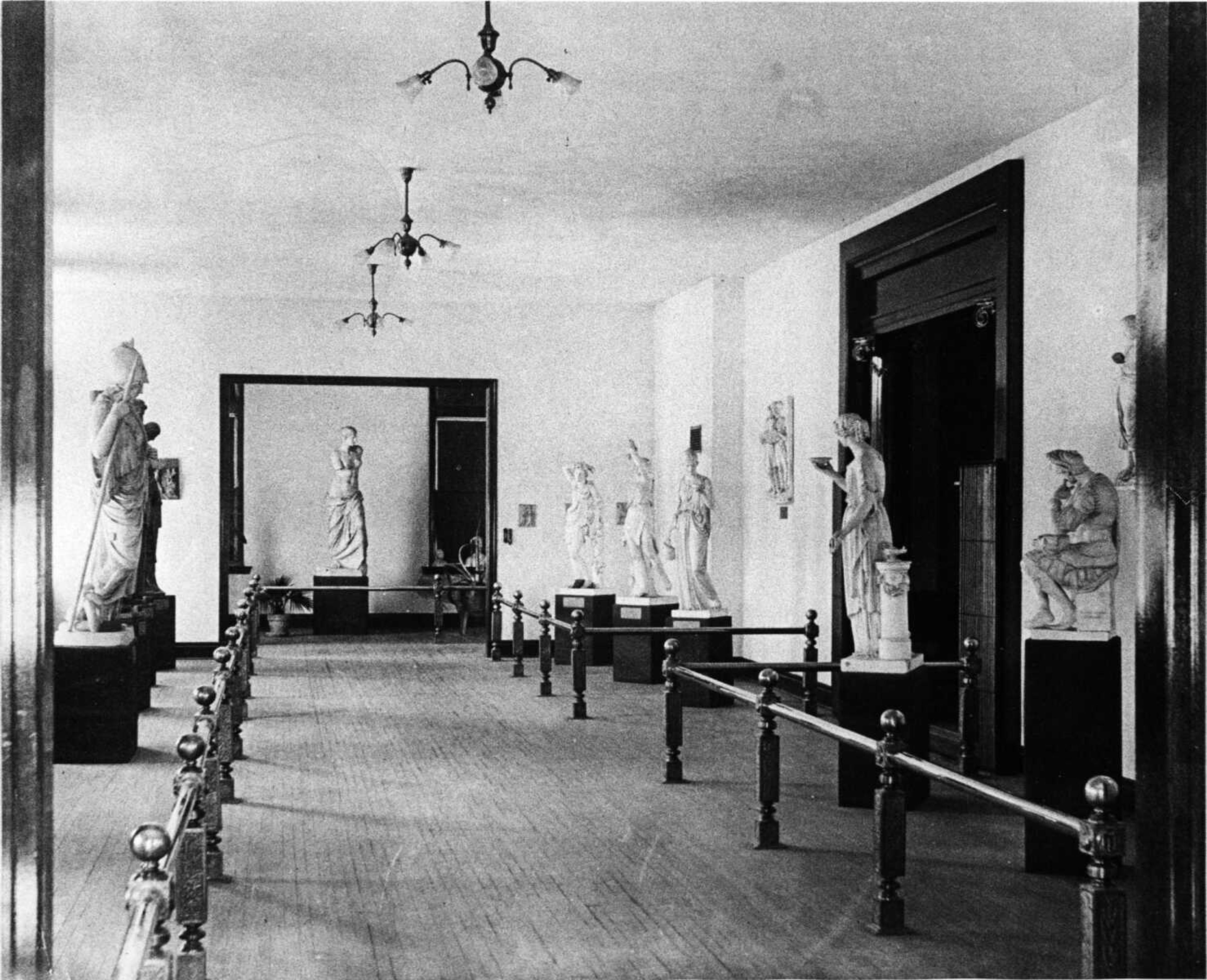Bicentennial: Cape's connection to 1904 St. Louis World's Fair
A trip to the Wehking Alumni Center on the Southeast Missouri State University campus will allow a visitor the opportunity to step back in time. Inside Wehking are art reproductions more than a century old, donated to the university by railroad pioneer Louis Houck...
A trip to the Wehking Alumni Center on the Southeast Missouri State University campus will allow a visitor the opportunity to step back in time.
Inside Wehking are art reproductions more than a century old, donated to the university by railroad pioneer Louis Houck.
Houck, who served a total of 40 years on Southeast's governing Board of Regents, had visited the 1904 World's Fair in St. Louis.
While there, Houck purchased a collection of 60 art pieces by August Gerber of Germany.
Gerber's work won him a gold medal at the nearly nine-month-long fair.
Impressed with its beauty, Houck bought Gerber's collection for $1,888.25 ($57,113 in 2021 dollars).
Originally placed in Statuary Hall at Southeast's Academic Hall, nine of those reproductions are installed today at Wehking.
"The St. Louis World's Fair was not the first of its kind, but it was the first one many Americans took notice of," said historian Nickell.
By the numbers
The Chicago World's Fair, technically referred to as the "World's Columbian Exposition," was the largest such fair, drawing an estimated 27 million people between May and October 1893.
Just more than a decade later, St. Louis's Forest Park was the stage for the 1904 Fair, drawing approximately 20 million between April and December 1904.
America's population was notably smaller in the first decade of the 20th century, as the Census Bureau reported only 82 million people were living in the then-45 U.S. states in 1904.
An estimated 62 countries and 43 states had exhibition booths on the 1,200 acres of Forest Park fairgrounds -- an area at the time larger than New York's famed Central Park.
The fair's formal name was the "Louisiana Purchase Exposition," staged in honor of the 1803 acquisition of 828,000 square miles by the fledging United States -- a massive addition that included what is now the entire state of Missouri.
The U.S. paid France $15 million for the territory, or $18 per-square-mile, for land covering what is now all or part of fifteen states.
Travel from Cape
"A railroad was built from St. Louis to Cape Girardeau, enabling many southeast Missourians to travel to the fair," said Nickell, who added in the nascent days of the 20th century it could take 12 hours to get to Cape from St. Louis by riverboat.
"The train trip cut the travel between the two cities to four hours," said Nickell. "You could take the train from Cape in the early morning, stay all day at the fair and be home the same day."
"The greatest growth of Cape Girardeau happened between 1905 and 1931, and I suspect the World's Fair and the railroad had a lot to do with that," opined Nickell.
Famous people
Geronimo, the former war chief of the Apache, was featured in a teepee in the Ethnology Exhibit.
"Geronimo was essentially confined to a cage, as he was then a prisoner of the U.S., and he got paid for his participation," said Nickell.
Helen Keller, then just 24 years of age, gave a lecture.
John Philip Sousa, the famous composer and conductor, was there, and it is believed the inventor Thomas Edison attended -- as did poet T.S. Eliot and the famous distiller of Tennessee whiskey, Jack Daniel.
The Naeter brothers, Fred and George, stopped off in Cape Girardeau on a riverboat excursion during the fair and were inspired to buy the remnants of the recently defunct Daily Republican newspaper, which in time became the Southeast Missourian.
"Rush Limbaugh Sr., who grew up in Bollinger County, went to the Fair as a young man and was known to have told of seeing a light bulb turn on and off there, unlike anything the legendary attorney had ever before seen," said Nickell.
Foods
"Remember it can get very hot in the summer in St. Louis, so some famous foods may have been introduced at the Fair -- waffle ice cream cones and iced tea, for instance," said Nickell.
Other foods said to have been popularized at the fair included cotton candy, the Dr Pepper soft drink, puffed wheat cereal and hot dogs.
"One historian has called the St. Louis World's Fair of 1904 the first food court," said Nickell.
Impact
"It's really an astonishing story," said Nickell, adding the 1944 movie, "Meet Me in St. Louis," kept St. Louis and Missouri in front of the country's attention for decades.
"The fair was a major turning point for Cape Girardeau," added the historian, noting as people up north took the train down to Cape, they saw Academic Hall and in short order, Southeast's enrollment grew rapidly.
Odds 'N Ends
The largest musical organ ever built at the time was constructed for the St. Louis World's Fair by the Los Angeles Organ Company, which shortly thereafter went out of business.
John Wanamaker bought the organ and put it in the Philadelphia Macy's department store.
Infant incubators were seen for the first time at the fair.
Nickell said the St. Louis event had a little of everything, even a riot.
"The United States had outlawed bullfighting, but there were international exhibitors and Spaniards staged bullfights," he said, adding, "people threw rocks and tore down the (fair's) admissions office."
Connect with the Southeast Missourian Newsroom:
For corrections to this story or other insights for the editor, click here. To submit a letter to the editor, click here. To learn about the Southeast Missourian’s AI Policy, click here.









